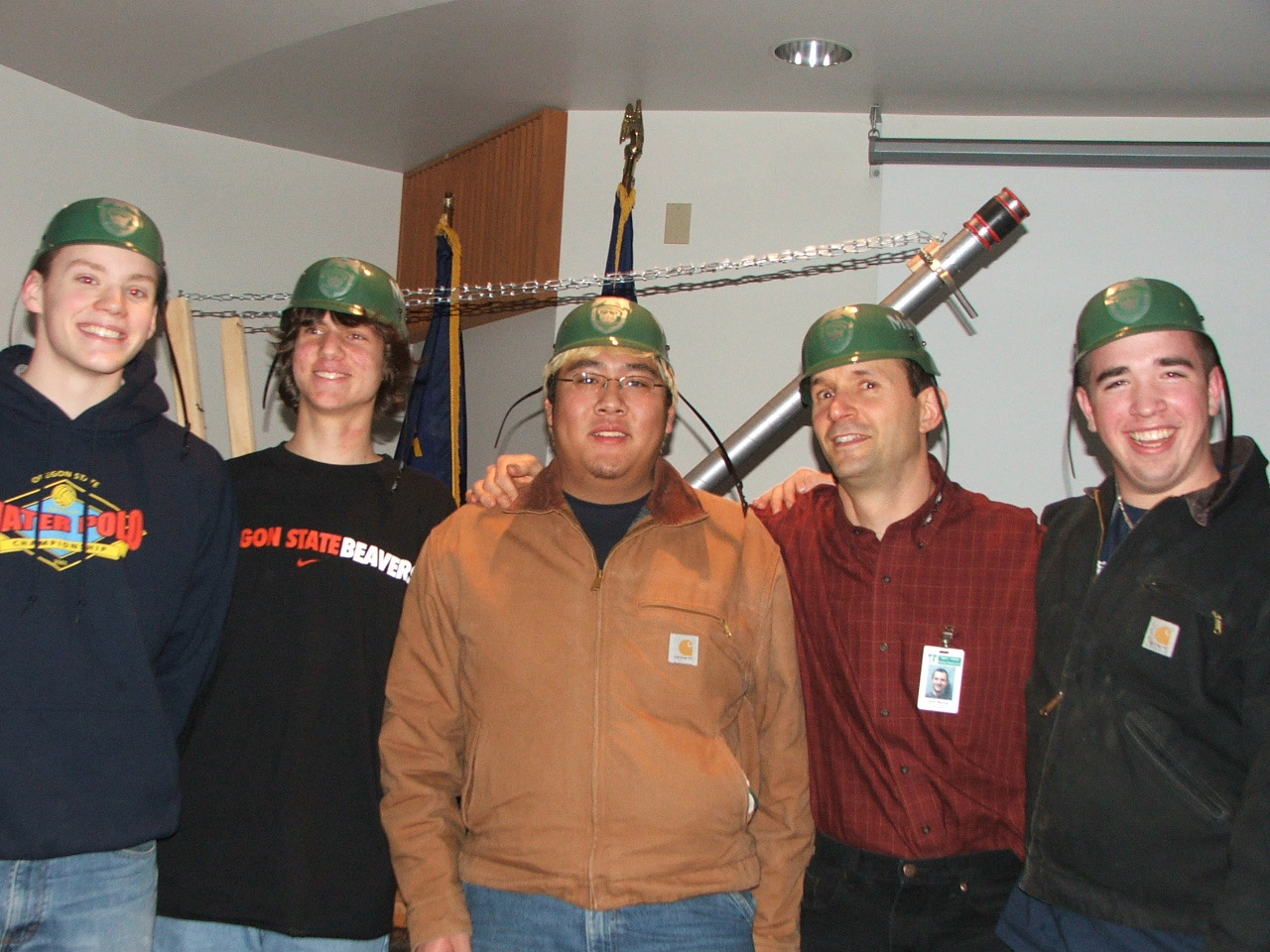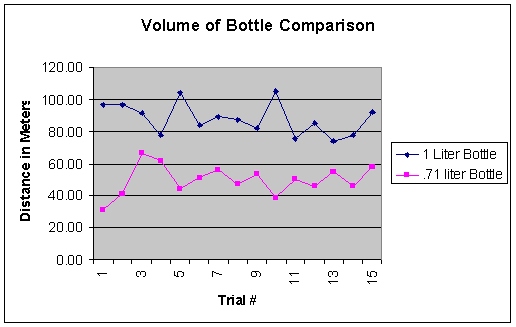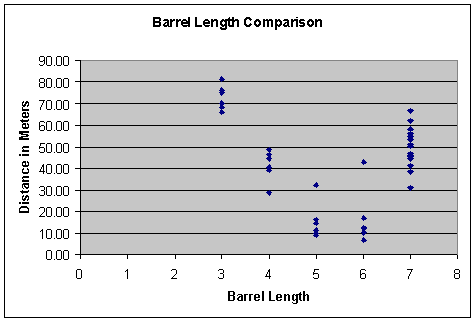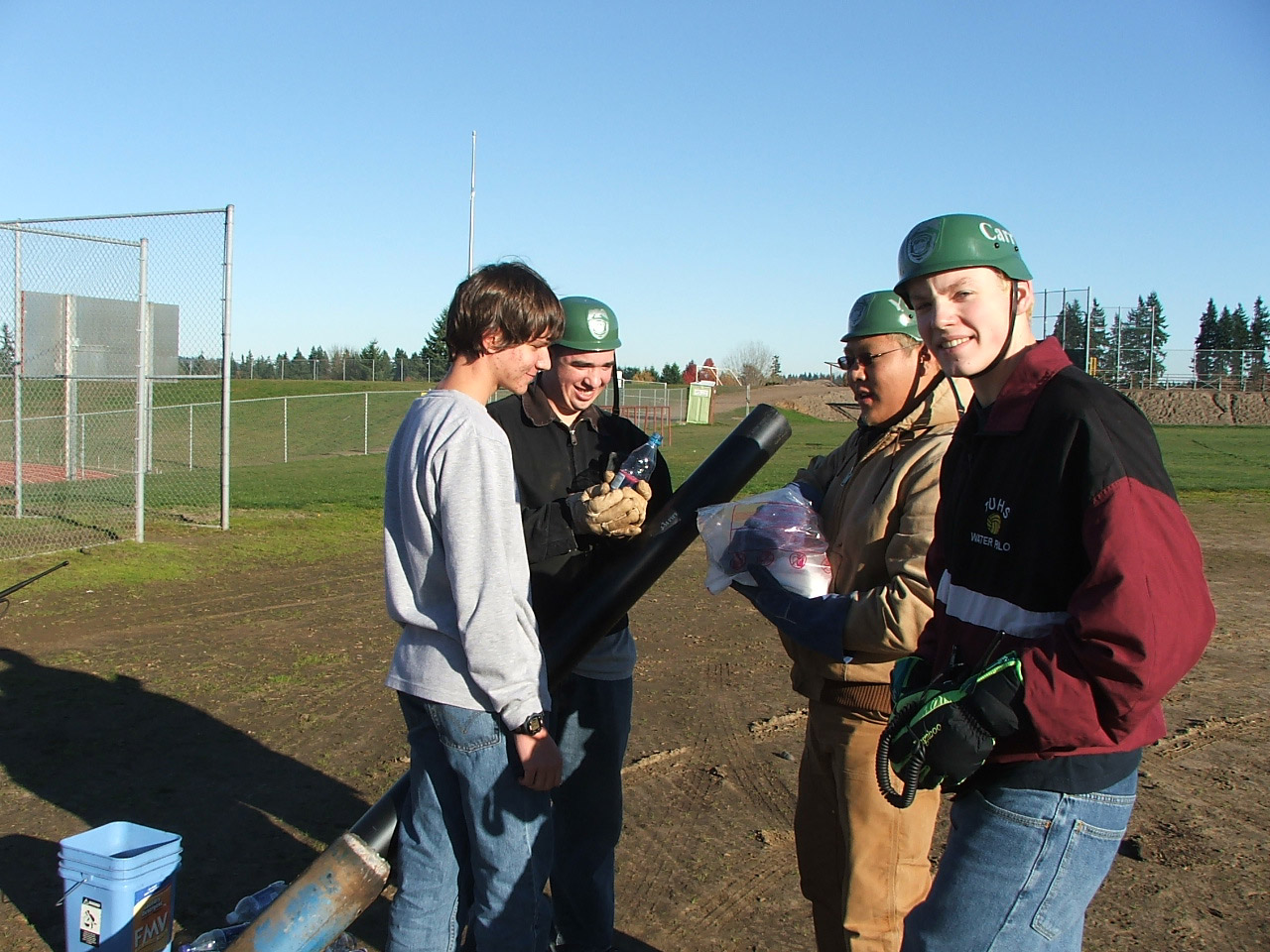
!!!!Don't try this at home!!!!
The Team.:.Introduction.:.Method.:.Results and Discussion.:.Conclusion.:.Bibliography.:.Photos and Movie .:. Return to Research

The team Left to Right: Ben Carr, Brant McGee, Nicholas Young, Mr. Murray, and Sam Koch
Introduction
Background: Cannons typically use a heat-based explosion to propel an object a distance at high speeds. The way cannons work is they channel an explosion in one direction, causing anything in its way to be moved. In this project we are going to use a pressure-based explosion. Using dry ice we can cause a closed container to blow up from the gas inside. We have to use a gas because a liquid does not change volume enough from a solid (gov). A container should blow up at a given point no matter how much dry ice we put in (DoChem). If it blows up at the same pressure than the force output should be the same. The cannon ball will then fly out of the container. Conservation of energy and momentum states that the ball will tell us through linear kinematics how much force was output. Therefore the change in ball size should not affect the overall outcome of force given off (digitalbrain).
Statement of the Problem: The purpose of this investigation is to 1) find out if the volume of bottle is significant to the force output if the explosion if the amount of dry ice stays the same. 2) prove the conservation of momentum while making the shot more aerodynamic.
Review of Literature: There are many different variables involved with this project. Namely dry ice phase change, volume versus pressure, force, the laws of conservation of momentum and energy, and angular momentum. The dry ice phase change will affect the force output because the volume should build up at a constant rate from solid directly to a gas (gov). The increased volume of the matter inside the container will create an enormous amount of pressure due to the molecules taking up more space (DoChem). The force given off by the explosion can be calculated from the cannon ball (digitalbrain). From the laws of conservation of energy and the conservation of momentum the energy expended will be the same if the force output is the same(hyperphysics). Therefore if we change the mass of the cannon ball the distance should change proportionally according to the equations (physics.about).
Hypothesis: 1. We believe that with a larger volume of bottle, the projectile will travel further. If the mass of dry ice remains the same, then the larger volume will propel it further. We will measure the volume of the container with water and then measure the mass of the dry ice we put in it. The distance will be measured by how far the nalgene bottle flies horizontally.
2. We believe as the length of the cannon barrel decreases, the projectile will travel less distance horizontally. We will measure this by keeping the angle of the cannon the same and measuring the distance traveled.
Method
The setup for the cannon was simple. We dug a whole in the ground and put in a short metal pipe as a sleeve, covering it with dirt and solidifying the angle. We then had seven-foot long section of PVC pipe, with a cap we glued on the end, as the cannon that we put inside the sleeve. As an explosive we used empty soda bottles with 1/8 of a pound of dry ice and hot water in them. The bottle sizes we tested were .71 liter (24 oz.) and 1 liter bottles to compare the bottle size to the distance of the shot. We used all 24oz. bottles to test the length of the barrel to distance of the shot. As ammunition we used a Nalgene bottle full of water that weighed 2 3/4lbs. The process was to fill the bottle with dry ice and hot water, then screw the cap on tight and put it in the barrel. Then we put more hot water into the barrel to speed up the expansion process of the dry ice. The ammunition was also put into the tube and we would wait for the explosion. Last we would measure the distance with a Jones Wheel from the end of the barrel to the bottle=s divot in the ground. The barrel would always stay in the same spot since it was buried. We emptied the barrel and repeated the process many times. The data collected becomes a ratio without any calculations needed because we kept all possible variables the same.
.:.To Top.:.
Results and Discussion
For our first hypothesis, we proved it correct by shooting 15 bottles of each size. The data was consistently higher with the one liter bottles as opposed to the 24 oz. Bottles. As seen by this graph all of the one liter bottle shots went farther than the 24 oz. Bottle shots. The shortest one liter length was 74.09 which was 8.4 M longer than the longest 24 oz. Bottle length of 66.69 M.

The results of the shorter barrel length turned out to be parabolic. The shorter lengths generally shot farther than the longer lengths. The shortest average was from the 1.52 M barrel. The .91 M barrel length shot about 60 M longer on average than the 1.52 M barrel. The data from the 2.13 M barrel was more spread out and therefore inconclusive, but it was about 40 M farther on average than the 1.52 M barrel.

Data File
One Hypothesis that would account for the barrel length is that the friction on the bottle would be less so it fired farther, conversely the longer the cannon the more accurate it would be at firing at the angle chosen.. Further research in this area could include accuracy of the shot and how friction and rifling could affect the outcomes. Another topic could be the amount of force output compared to how the bottle blows up. From our observations when the cap of the bottle blew off instead of the bottle blowing up the shot distance would significantly decrease, raising more questions like how the strengths of plastics relate.
.:.To Top.:.
Conclusion
A: We hypothesized that if the volume of our propellant device is larger then the propelled object will go farther. We were correct; we tested two different volumes of bottle, one liter bottles and .71 liter bottles. The one-liter consistently went further. We conducted fifteen trials for each volume, which gave us sufficient data to make this assumption.
B: We hypothesized that the shorter the barrel of the cannon the shorter the distance that the propelled object will go. We were wrong, we tested five different lengths of barrel, 2.13 m, 1.83m, 1.52m, 1.22m, and .91m. Instead of the decreasing function we thought we were going to get, we saw a parabolic relationship. At first the data supported our conclusion, but once the barrel was shortened beyond 1.52m the distance of the shot actually increased. We conducted five trials at each length.
A/B Errors: There were many opportunities for error in this investigation. The amount of water we used to accelerate the reaction was hard to keep track of. While we measured the amount of dry ice that we used, and kept it constant, the fact that it is constantly sublimating prevents complete exactness. Human error was a factor, as always, when measuring with the Jones Wheel. The measurer probably didn’t walk exactly straight and the weights not exactly the same. The levelness of the ground was not much of a factor but was not exactly level. Wind pushing the propelled object was minimized by the weight of the object that we shot.
Our project may not have been the safest but it was definitely one of the most fun. Nick Young of the bomb squad only had to diffuse two shots. We spent a lot of time building the apparatus, buying the parts, and getting data. But in the end, it was all worth it. Our project would have been much more exact if we had the money for the big exact tools, but we didn’t. So I guess the results we got will have to suffice…for now.
R. Nave AConservation Laws@ HyperPhysics
http://hyperphysics.phy-astr.gsu.edu/hbase/conser.html#conamo
It helped us with understanding systems of external force.
ADoChem075" July 1998
http://129.93.84.115/Chemistry/DoChem/DoChem075.html#Data%20Analysis
Why does an explosion occur?
Department of energy USA AAsk a Scientist@
http://www.newton.dep.anl.gov/askasci/chem99/chem99090.htm
This site revealed the nature of dry ice and how it changes phases.
AForce and Non-uniform Motion@ Digital brain
http://www.digitalbrain.com/digitalbrain/web/subjects/2.%20secondary/ks4sci/su4/mod2/mod2hi.db_psc?verb=view
It helped us discover our terminal velocity.
AExplosions and conservation of Momentum@
http://physics.about.com/cs/workedproblems/a/141003.htm
A general overview of the topic.
Cannon Movie http://tuhsphysics.ttsd.k12.or.us/Photos/05-06/IBIIsetup/DontDoThisAtHome2.WMV
